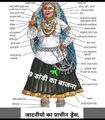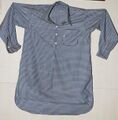Jat costumes
| Author:Laxman Burdak, IFS (Retd.) |
Jat costumes and dresses are simple.
Man's garments
- The men's dress in Rajasthan consists of:
a white turban, shirt, dhoti, jooties and cotton or woolen shawl. Jats narmally keep with them woolen blanket made of sheep-wool during winters.
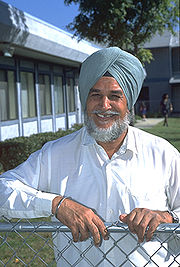
- The men's dress in Punjab consists of:
The typical Jat dress: "The well to do Jat has his clothes made of better materials, and will generally indulge in a well-fitting waist coat and a black or coloured coat made of broad cloth or alpaca according to the season. They wear colourful sleeveless jackets. In modern days, South Asian leaders and other well to do males generally wear a long coat called "Achkin" along with a tight fitting trouser called "Churidar Pyjama".
Women's garments
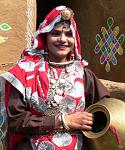

In Punjab
The dress of the women is brighter always some colour in it. A wrap is always worn over the head. With this are worn a loose jacket and either an ample pair of pyjamas tight at the feet, or apetticoat
In Rajasthan
- Women wear orhni (ओढणी) (veil) shirt or Angia (short blouse) ghagri (heavy skirt) jooties (country made shoes)and heavy ornaments around the neck, wrists and ankles.
- Rajasthani women wear kurti (कुर्ती), kanchali (कांचळी) and ghaghara (घाघरा).
- Traditional jat women wear woolen ghaghara known as dhabala (धाबळा) with a strong woolen rope tied to it in the waste.

Ornaments

There are different kinds of ornaments in use in different states. Ornaments are liked by both jat men and women.
Men's ornaments
Men in Uttar Pradesh wear:
- gande (गंडे),
- tore (तोड़े),
- janjir (जंजीर),
- anguthi (अंगूठी),
- chhap (छाप),
- birbali (बीरबली),
- baliyan (बालियां) etc.
Men in Punjab wear:
various types of gold jewellery. "Kaintha" (necklace for males), "Murki" (earrings for, usually, married women), "Mundri" (earrings for the males), and "Mundi" (ring) are some common ones.
Jewellery of the Jat is roughly of three kinds, necklaces of gold and coral beads strung together called "mahla"; bracelets of gold or of silver called "Kangan", and rings of silver or gold and roughly set stones called "Mundi".
Earrings are found on most of the bodies; the men wore only one whilst women had two. Finger rings were universal, and several are often discovered on each finger of both hands
Men in Rajasthan wear:
- kare (कड़े) in ankles,
- gurde (गुर्दे) and murki (मु्र्की) in ears and
- har (हार) in neck.
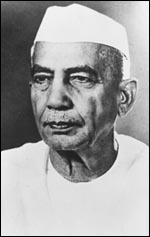
Men in Uttar Pradesh also wear:
- White cap ("Topi") which is also famous as "Gandhi Topi". Jat leader and ex-Prime Minister of India, Chaudhary Charan Singh also used to wear this white cap, as can be seen in photograph here.
- White Kurta and traditional 'dhoti' - same way as in Rajasthan and Haryana.
Women's ornaments


Women wear various ornaments made of gold and silver such as bichhue (बिछुए), sankar (सांकर), chhalli (छल्ली), chhade (छड़े), lachhe (लच्छे), sankari (सांकरी), kare (कड़े), pajeb (पाजेब), santh (सांठ), bankada (बांकड़ा), kamardhani (कमरधनी), hamel (हमेल), janjir(जंजीर), guluband (गुलबंद), hansali (हंसली), kanthi (कंठी), pachamania (पचमणिया), mohanmala (मोहनमाला), jhumka (झुमका), long (लॉग), eran (एरन), vali (वाली), turputi (तुरपुती), jhubjhubi (झुबझुबी), nath (नथ), borla (बोरला), sentha (सेंठा), long (लॉग), sulliya (सुल्लिया), Teoto (टेवटो), madalio (मादळियो), bangari (बंगड़ी), anvala (आंवळा), nevari (नेवरी), pati (पाती), Bala (बाळा) (Ear ring) etc.
The pictured golden ornament mhel is the most prized ornament and is considered as status symbol in jat marriages.
Gallery
-
Traditional Haryanvi Jat men's dress & ornaments
-
Traditional Haryanvi Jat women's dress & ornaments
-
बच्चे की टोपी
-
कुरुक्षेत्र विश्वविद्यालय में एक घाघरी प्रदर्शनी
-
चुन्दड़ी पर हस्तकला
-
एक और पुराने स्टाइल की चुन्दड़ी
-
आंगी (पुराने स्टाइल की ब्रा)
-
पुराने फैशन वाली एक सुन्दर घाघरी
-
जनाना कुर्ता
-
पुराने स्टाइल का रजाई का गिलाफ
-
रेजे की कढ़ाई वाली लुगड़ी
Back to People



